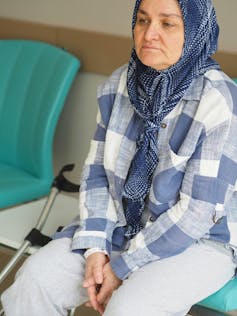In Québec, immigrants are more likely to be injured at work than people born in the province. Yet the hardest part for immigrant workers often starts after the accident, when they have to navigate a complex rehabilitation system that slows their recovery and their return to work.
My team and I have conducted several studies on the post-injury rehabilitation journeys of immigrant workers as part of our research at the Institut de recherche Robert-Sauvé en santé et en sécurité du travail (Robert Sauvé Research Institute in Occupational Health and Safety, or IRSST).
Our findings show a series of systemic, institutional and relational barriers that hinder their recovery.
Table of Contents
Troublesome figures
In 2016, we found that foreign-born people had a 31 per cent higher rate of workplace accidents than Québec-born individuals, according to a study based on data from the province’s Commission des normes, de l’équité, de la santé et de la sécurité du travail, combined with other ministerial data (the Commission on Standards, Equity, Health and Safety in the Workplace, or CNESST).
The risk is particularly high among newcomers to Canada (less than five years), who are 1.4 to 1.6 times more likely to have an accident.
But the difficulties do not end with the accident. Immigrants represent 21 per cent of the working population, but nearly 30 per cent of long-term workers’ compensation cases (90 days or more).
(Unsplash)
The relative risk of a long-term absence from the workforce is 65 per cent higher among immigrants than it is among people born in Canada. This data suggests either that immigrants are particularly susceptible to serious injury, or that they tend to report their injuries later, when they may have worsened.
The sectors that are most affected are health and social assistance, administrative services, support services and waste management, manufacturing, construction and retail trade.
More difficult recovery
One of the studies we conducted showed that immigrants are at greater risk of accidents that result in prolonged absences due to the dangerous nature of their jobs, unstable employment, lack of recognition of their qualifications and a lack of knowledge of their occupational health and safety rights.
This increased risk is accompanied by more difficult access to compensation, particularly due to late reporting, administrative obstacles, language barriers and mistrust of institutions.
In our qualitative research, several injured immigrants expressed discomfort with how their stories were received, including pain perceived as exaggerated, doubts about their credibility and implicit expectations of conformity to institutional norms. This disconnect — often fuelled by unconscious biases related to origin or language — contributes to a weakening of the bond of trust.
Similar findings have been reported across Canada.
The weakened therapeutic alliance
In another field study, we explored the concept of the therapeutic alliance in a multi-ethnic context. This concept refers to the relationship of trust built between a health-care professional and a patient.
We found that this therapeutic alliance is often weakened due to the complexity of administrative procedures, differing medical opinions among professionals and expectations of a return to work that are disconnected from patients’ realities.
“I stopped asking questions. Every time, it was as if I was bothering them. I realized that if I wanted to move forward, I had to keep quiet,” said a worker from the Caribbean who worked as a patient care assistant and suffered from a lumbar sprain. She had been a technician in a medical laboratory in her country of origin.
This type of experience causes many people to disengage. Such withdrawal does not reflect a lack of will, but rather, a loss of meaning.
Another interviewee who worked as an educator before quitting due to hip bursitis, expressed — like many others — a shift in identity:
“I would like to change careers, really. I don’t think I belong there … as an educator. I can do better.”
She had been trained in management in her country of origin.
Professional downgrading, rarely discussed, becomes a driver for repositioning one’s identity. These stories illustrate that rehabilitation is not limited to a physical return to work, but involves psychological, social and migratory dimensions.
A fragile but promising response
Faced with these challenges, some health-care settings are developing strategies such as the “relay alliance.”
This involves identifying the professional within the team who has established a relationship of trust with the injured person and entrusting them with the most sensitive interventions. This approach can sometimes restore communication and commitment where the system has failed.
This strategy is fragile, however. It relies on stable teams, interpersonal skills and an institutional margin of manoeuvre, which is often limited.
Learning to provide better support: concrete ideas
The findings of this research call for concrete changes:
-
Reduce fragmentation of pathways and changes in caregivers;
-
Train teams to recognize the systemic effects of migration;
-
Adapt interventions to actual migration trajectories;
-
Recognize lived experience as a source of knowledge.
Some organizations have already begun this shift. At the CNESST, a co-construction approach was used to produce an intercultural communication support tool based on real-life situations: “We didn’t want a fact sheet on each culture. We wanted to reflect on our practices, on what works and what doesn’t,” said one of the people we interviewed.
(Unsplash)
This change must also be collective: “It’s not just a matter of individual training. Our teams need to talk about it, and we need to give ourselves collective resources,” said a CNESST rehabilitation manager.
As an extension of this joint effort, we have published a guide, La rencontre interculturelle: enjeux et stratégies d’intervention auprès des personnes immigrantes ayant subi une lésion professionnelle (Intercultural encounters: issues and intervention strategies for immigrants who have suffered a work-related injury), written for health-care professionals and occupational health and safety practitioners.
Together with occupational therapist Julie Masse, we also designed a continuing education course offered at the Université de Montréal and tested in various health-care settings, based on health anthropology and occupational therapy, to encourage a reflective approach to interculturality.
Repairing differently
Behind every injury, there is a life story. And behind every life story, there is a society that chooses — consciously or not — to either support or exclude.
To build a more equitable rehabilitation system, we must first recognize the diversity of life stories, aspirations and relationships to work.
Let’s rethink diversity not as a slogan, but as an invitation to transform our institutions, our practices and the way we think about our work.
























